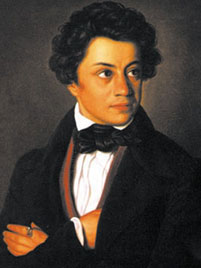
Julius Mosen (8 July 1803 – 10 October 1867) was a German poet and author of Jewish descent, associated with the Young Germany movement, and now remembered principally for his patriotic poem the Andreas-Hofer-Lied .

Julius Mosen (8 July 1803 – 10 October 1867) was a German poet and author of Jewish descent, associated with the Young Germany movement, and now remembered principally for his patriotic poem the Andreas-Hofer-Lied .
Julius Mosen (Julius Moses) was born at Marieney in the Saxon Vogtland, the son of Johannes Gottlob Moses, the cantor and schoolmaster of Marieney. He studied at the Gymnasium in Plauen from 1817 to 1822, and afterwards studied law at the University of Jena. During a two-year-long visit to Italy, he received the inspiration that resulted several years later in his major works (Ritter Wahn, Cola Rienzi, Der Kongreß von Verona).
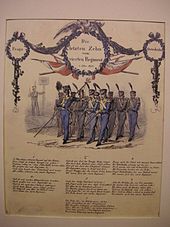
On his return, he finished his law studies at Leipzig, where he then worked as a lawyer. From 1835 to 1844 he was an independent advocate in Dresden. He had meanwhile shown great literary promise in his Lied vom Ritter Wahn (1831). This was followed by the more philosophical Ahasvar (1838), and by a volume of poems, Gedichte (1836, 2nd ed., 1843), among which Andreas Hofer and Die letzten Zehn vom vierten Regiment became popular. As an active freemason in Dresden he encountered several important literary figures, including Ludwig Tieck, Ludwig Uhland, Georg Herwegh, Richard Wagner and Gottfried Semper, and was soon himself reckoned to be among the best-known German poets.
He also wrote the historical plays Heinrich der Fünfte (Leipzig, 1836), Cola Rienzi, Die Bräute von Florenz, Wendelin und Helene and Kaiser Otto III (the four last being published in his Theater 1842). His tragedies were very well received and were performed at the Dresden court theatre (Dresdner Hofbühne). For his services to German theatre the faculty of Philosophy at the University of Jena awarded him an honorary doctorate.
In addition he tried his hand at fiction, in his only novel, the politico-historical Der Kongress von Verona (1842), and in a collection of short stories published in 1846, Bilder im Moose.
In 1844 the Grand Duke Paul Friedrich August von Oldenburg offered him the appointment of dramaturgist at the Court Theatre in Oldenburg, which he accepted, in the hope of putting into practice his vision of German national theatre. In the same year he had his family name changed from "Moses" to "Mosen" by Dresden ministerial decree. In 1846 he was stricken with paralysis as the result of a rheumatic illness, and after remaining bed-ridden for the rest of his life, died at Oldenburg on 10 October 1867. He was buried in the churchyard of St. Gertrude's Chapel (Gertrudenfriedhof) in Oldenburg.
Of his later works may be mentioned Die Dresdner Gemäldegallerie (1844), and the tragedies Herzog Bernhard (1855) and Der Sohn des Fürsten (1858). A collection of his works, Sämtliche Werke, appeared in 8 volumes in 1863 (a new edition was produced by his son, with a biography, in 6 volumes in 1880).
His best-known poem is the text of the "Andreas-Hofer-Lied" ("Zu Mantua in Banden"), the present anthem of the Austrian Bundesland of the Tyrol. Robert Schumann wrote a lied using as lyrics his poem 'Der Nussbaum' (the walnut tree). German composer Georgina Schubert used his text for her lieder “Der traumende See.” [1]
There are three principal themes in Mosen's life and work: love of the home country, the battle for freedom, and the now-destroyed German-Jewish symbiosis.
In Erinnerungen ("Memories"), he writes of the "dependency on the soil of home, the Vogtland" that draws and holds the gaze "as though yonder, far back in the distance beneath the sap-dripping pines, there where the mountains rise up like terraces in dark blue, some secret were hidden that lures us to it and that would gladly reveal itself to us". [2] The Vogtländer for him are the "Saxon Tyrolese, only pleasanter, livelier, more persistent in the pursuit of their goal, but just as sober, if also rougher." [3]

Johann Ludwig Tieck was a German poet, fiction writer, translator, and critic. He was one of the founding fathers of the Romantic movement in the late 18th and early 19th centuries.

Nikolaus Lenau was the pen name of Nikolaus Franz Niembsch Edler von Strehlenau, a German-language Austrian poet.

Nikolaus Alois Maria Vinzenz Negrelli, Ritter von Moldelbe was a Tyrolean civil engineer and railroad pioneer mostly active in parts of the Austrian Empire, Switzerland, Germany and Italy.
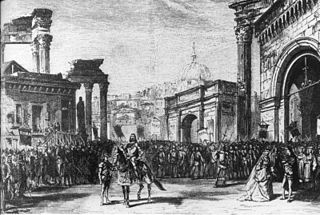
Rienzi, der letzte der Tribunen is an 1842 opera by Richard Wagner in five acts, with the libretto written by the composer after Edward Bulwer-Lytton's novel of the same name (1835). The title is commonly shortened to Rienzi. Written between July 1838 and November 1840, it was first performed at the Königliches Hoftheater Dresden, on 20 October 1842, and was the composer's first success.

Peter Schreier was a German tenor in opera, concert and lied, and a conductor. He was regarded as one of the leading lyric tenors of the 20th century.

Baron Eligius Franz Joseph von Münch-Bellinghausen was an Austrian dramatist, poet and novella writer of the Austrian Biedermeier period and beyond, and is more generally known under his pseudonym Friedrich Halm.
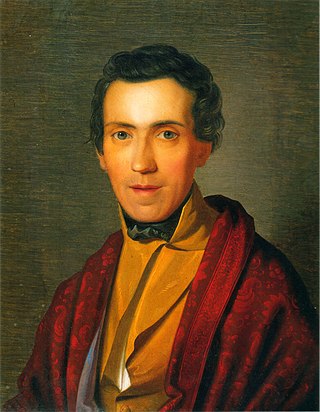
Adrian Ludwig Richter was a German painter and etcher, who was strongly influenced by Erhard and Chodowiecki. He was a representative of both Romanticism and Biedermeier styles.

Carl Gottlieb Reißiger was a German Kapellmeister and composer.

Johann Karl Bähr (1801–1869) was a German painter and writer.

Rolf Hoppe was a prolific German stage, cinema, and television actor, who played in more than 400 films in a career which spanned over six decades.
Julius Ludwig Ideler was a German philologist and naturalist. He was the son of astronomer Christian Ludwig Ideler.
Heiko Trinsinger is a German operatic baritone. A member of the Aalto Theatre in Essen, he has performed leading roles at major houses, such as Mozart's Papageno and Wagner's Alberich.
Karl Gaillard was a Prussian writer and music journalist.

Helena Forti was a dramatic soprano active 1906 – 1924, closely associated with the Dresden royal court opera, known for her beauty, voice and strong stage presence. She sang all Wagner's opera heroines, in Dresden, Bayreuth and internationally. Other repertoire included the title role in Verdi's Aida, Santuzza in Mascagni's Cavalleria and contemporary works such as Marietta in Korngold's Die tote Stadt. She created the role of Myrtocle in d'Albert's Die toten Augen. Her Sieglinde in Die Walküre in Braunschweig was described by the Neue Zeitschrift für Musik as "Equally endowed with youth, beauty and vocal means... (Forti) immerses herself so intensely in her role that one believes the transformation of the virgin-Goddess into a human form." After retiring from the stage she taught voice and acting in Gera, Düsseldorf and Vienna. She died in Vienna, where she lived with her stage director and Intendant husband, Walter Bruno Iltz.
George Washington Pittrich was a German composer and Kapellmeister.
Ernst Wachter was a German operatic bass and music educator.

The Königliches Hoftheater in Dresden, Saxony, was a theatre for opera and drama in the royal seat of the Kingdom of Saxony from 1841 and 1869, designed by Gottfried Semper. It was the predecessor of today's Semperoper, and is therefore sometimes called Altes Hoftheater.
Johannes Woldemar Gelbke was a German composer, choir lieder, conductor and singer He became known especially in Germany for his song Horch! Die alten Eichen rauschen... ("Heimkehr"). He also worked as a composer, conductor, choirmaster and singer in the US, where he lived and worked from 1882.
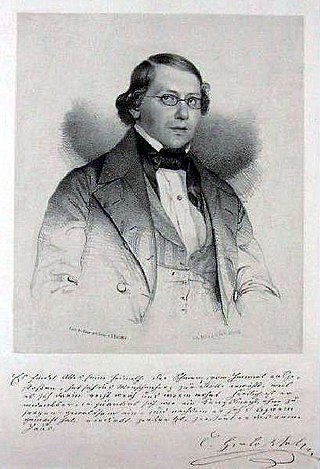
Carl Herloßsohn or Karl Herloßsohn was a German author, journalist and encyclopaedist.